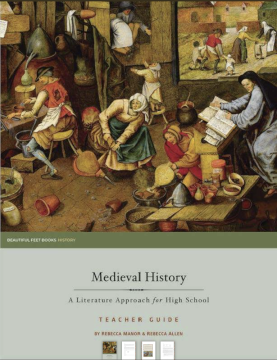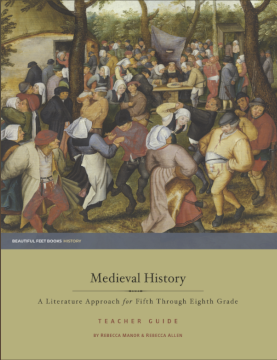Beautiful Feet offers two different guides for the study of Medieval History using real books, Medieval History: A Literature Approach for Fifth Through Eighth Grade by Rebecca Manor and Rebecca Allen (published in 2023) and Medieval History: A Literature Approach for High School by Rebecca Manor and Rebecca Allen (2024). Both guides cover the period from the fall of Rome through the early 1500s. They follow the same timelines, often covering the same or similar topics, so it’s fairly easy to have different students working through both guides at the same time.
These guides lay out reading schedules for two wonderful collections of living books, along with questions, activities, internet links, and recipes. Both guides feature lovely, full-color illustrations, including artwork from each period.
Books Used with Each Guide
There is some significant overlap in the two guides, with both using The European World by Barbara Hanawalt as a spine throughout the course and Genevieve Foster's The World of Columbus and Sons in the seventh unit. Both studies use different versions of Beowulf, The Adventures of Robin Hood, and The Canterbury Tales, while the rest of the books are different for each level.
Selected chapters and pages from The European World provide an overview with more comprehensive information to ensure thorough coverage. While students at both levels sometimes read the same chapter(s), more often they read different sections of that book. With The World of Columbus and Sons, students at both levels often read the same pages and answer almost identical questions. However, older students are sometimes assigned additional pages to read.
Along with the books I’ve already listed, the study for younger students uses several other books, such as Queen Eleanor: Independent Spirit of the Medieval World by Polly Schoyer Brooks; Castle by David Macaulay; The Magna Charta by James Daugherty; Morning Star of the Reformation by Andy Thompson; The Trumpeter of Krakow by Eric P. Kelly; The Story of Joan of Arc by M. Boutet de Monvel; I, Juan de Pareja: The Story of a Great Painter and the Slave He Helped Become an Artist by Elizabeth Borton de Treviño; and The Royal Kingdoms of Ghana, Mali, and Songhay: Life in Medieval Africa by Patricia and Fredrick McKissack. There are 20 required books for this study.
At the older level, students frequently read from Anthology of Medieval Literature, second edition, a book compiled and edited by the authors of the study guides. The other required books for the upper level are Beowulf translated by Seamus Heaney, Anna of Byzantium by Tracy Barrett, A Proud Taste of Scarlet and Miniver by e.l. konigsburg, The Merry Adventures of Robin Hood by Howard Pyle, Shakespeare’s plays King John and Henry VIII, Ibn Battuta: The Journey of Medieval Muslim by Edoardo Albert, A Single Shard by Linda Sue Park, The Canterbury Tales by Geoffrey Chaucer, and The Walls of Cartagena by Julia Durango.
Beautiful Feet sells the guides by themselves or in packages for each level that include the guide, the required books, map, and timeline.
At the younger level, parents might read aloud with some fifth and sixth graders, while seventh and eighth graders read independently. But your family might enjoy reading many of the books aloud together, no matter the ages of your children. Each family needs to figure out the balance between reading aloud and independently.
Additional books are recommended for each of the eight units of the guides under the heading “Rabbit Trails,” but I suspect most students will have plenty to read between the required books and internet source material. The guides let parents know that students do not need to read every page in every book. Students might even skip some books entirely, but not the spine books.
Most of the books used in both studies are religiously neutral even though they cover religious events. However, two books used in the lower level involve religious points of view: The Story of Joan of Arc by de Monvel (published by Beautiful Feet Books) has a Catholic slant, and The Morning Star of the Reformation has a Protestant slant. The treatment of Martin Luther and the Reformation uses several resources, including some on the internet, and is relatively neutral. Students might visit websites that offer Catholic, Protestant, or secular perspectives as they work through either level.
The Guides
 Both guides present 98 lessons, arranged in eight units. Students should complete three lessons per week. In the lower level, each lesson should take one to one and a half hours. Optional activities, videos, and suggested reading guarantee you will have more than enough material for a full school year. At the older level, lessons will take longer since there is a lot of reading, but the many optional activities make it impossible to predict how much time will be required. Parents (or students) should choose options that suit the student’s interests, abilities, and time requirements.
Both guides present 98 lessons, arranged in eight units. Students should complete three lessons per week. In the lower level, each lesson should take one to one and a half hours. Optional activities, videos, and suggested reading guarantee you will have more than enough material for a full school year. At the older level, lessons will take longer since there is a lot of reading, but the many optional activities make it impossible to predict how much time will be required. Parents (or students) should choose options that suit the student’s interests, abilities, and time requirements.
Recommended internet resources are from many sources, such as the Crash Course history videos, TED-Ed presentations, historic-UK.com, several museums, and both Protestant and Catholic websites. They are often listed as sources students might use as they research and write about particular topics. These internet resources are often excellent, so try to use as many as possible. The lessons include coverage of religious events while leaving room for parents and students to select options and activities that support their own beliefs.
Timeline and map activities in the lessons direct students to make entries on both the Medieval History Timeline and the large Medieval World Map (both published by Beautiful Feet Books), which are included in the bundle for each course.
The guides occasionally present vocabulary words for students to define in preparation for their reading, and they pose questions for students to answer as they work through the reading, videos, and research. Parents can choose how to use the questions. Many of the questions lend themselves to discussion rather than written work, and some questions might serve as essay topics. Answer keys to questions with predictable answers are at the back of each guide.
Students might use a notebook or binder to record vocabulary words, answers to questions, and research results. However, the guides also suggest that students create a portfolio of their work—reports, projects, photos, poems, etc. Recognizing that we live in the digital age, the guides say the portfolio can be a dedicated notebook, a website, or blog—whatever medium the student prefers.
Some activities are more complex than others. Activities, such as creating a medieval manuscript or writing a medieval ballad and performing it, might require additional resources and a significant amount of time, so parents should read ahead to select and prepare for activities, perhaps in consultation with students.
Each unit concludes with “Historic Table,” a recipe related to the historical period.
Parents who want to assign activities from among the options for either level might prefer the PDF versions of these guides so they can easily copy and paste assignments from the guide to a student assignment sheet.
While there are no tests for these studies, this approach to learning tends to be very effective for long-term retention since students usually become very engaged with the stories. Discussing and writing essay-type responses and reports, coupled with the internet and hands-on activities, help students assimilate information and process it at a deeper level than when they simply read a textbook, memorize information, and repeat it on a test.
Summary
These Beautiful Feet Guides for Medieval History have been significantly revised and updated to make use of some of the best resources available in print and on the internet. They provide a well-balanced blend of research, reading, videos, writing, and other activities.










